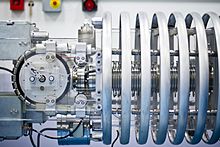Pelletron

The Pelletron (engl. Pellet : beads, tablet, pellet) is a high voltage source in particular for named after her particle accelerator . It is similar to the Van-de-Graaff generator - the high DC voltage in the double-digit megavolt range is also achieved by mechanically shifting electrical charges. The surrounding insulating band of the Van-de-Graaff generator has been replaced by a chain of metallic conductive bodies with insulating connections.
history
From 1946, work began at the University of Wisconsin on the required insulating bushings for the pressure vessels, on oil-free pumps and on the mechanics of charge separation. In 1965, Raymond Herb founded himself with the results and his inventions from the university and continued the developments with his company National Electrostatics Corporation to create the first modular devices. As a result, he succeeded in building a first three-stage accelerator for 22 MeV.
Layout and function
The devices are usually housed in sulfur hexafluoride pressurized gas tanks. An essential component is an endless chain made of metal bodies and nylon, which runs around two rollers similar to a conveyor belt. The initial charge is applied to the metal bodies of the chain by means of auxiliary voltage sources by means of influence , if the bodies are still in contact with the earth-side metal roller. The charge separation takes place when the bodies leave the role. From there they are transported to the high-voltage electrode, with mechanical work being done against the electrical field. As a result, the voltage increases and the charges are removed from the bodies inside the electrode by means of an arrangement similar to an influenza machine, before they are charged with inverse polarity after rotating around the second roller before descending to earth potential, which increases the efficiency of the Devices doubled.
In a pelletron tandem ion accelerator , negatively charged ions are first accelerated in the positive field of the pelletron to the hollow electrode, where they are stripped and further accelerated as positive ions against earth potential. The total effective acceleration voltage is therefore twice the terminal voltage of the pelletron, for example, first single negatively and then single positively charged ions reach 22 MeV at 11 MV accelerator voltage.
literature
- Frank Hinterberger: Physics of Particle Accelerators and Ion Optics . 2nd Edition. Springer, 2008, ISBN 978-3-540-75281-3 .
Web links
Individual evidence
- ^ RG Herb: The Pelletron Accelerator , in IEEE Transactions on Nuclear Science, Vol. 18, Issue 3, page 71ff, June 1971
- ^ Tuan Thien Tran: Synthesis of Germanium-Tin Alloys by Ion Implantation and Pulsed Laser Melting: Towards a Group IV Direct Band Gap Semiconductor , doctoral thesis 2017 at the Australian National University , page 21f
- ↑ https://sites.google.com/a/lbl.gov/rbs-lab/home/facility-introduction Lawrence Berkeley National Laboratory: Ion Beam Analysis Facility / Facility Introduction , accessed on Dec. 1, 2018